11 Fun Ideas for Exploring Nature with Kids

It's after school, and you have a bit of time before you have to start dinner. Or you’re in between appointments and have some time to kill at a local park.
Advertisement

What can you and your kids do outside in half an hour to connect to nature, de-stress, and get some fresh air? Lots! Read on for 11 fun activities that will help your kids explore and learn from the wildness that’s just outside their back door and down the street.
Start with Nearby Nature
You don’t need to spend the day in an old-growth forest to get the benefits of time in nature. Don’t overlook those imperfect corners of your backyard, a pocket park or nearby green belt, or the overgrown edges of city parks.
You might be amazed at how much wildness you can find in the scraggly edges of a tamer environment. My two children and I have found spiders, snakes, caterpillars, ladybugs, and even a salamander in the un-mown edges of our suburban lawn. We’ve also found interesting plants that have managed to self-seed and get a foothold where the lawn mower couldn’t reach them.
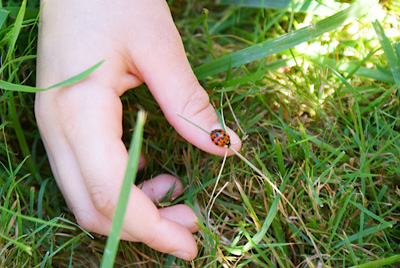
Focus In
Seeing the world through a magnifying glass changes our perspective and makes us see the world differently – and even preschoolers can be taught how to look at natural items up close.
My kids and I have been amazed at the hairs on leaves, the intricacies of flower parts and the details of shells. Simple hand lenses are a good place to start; we’ve gotten them at local toy or bookstores for just a few dollars. There are many now made especially for toddlers and preschoolers, or you can get higher quality jeweler’s loupes from The Private Eye. Its website also has lots of great information on the benefits of this method of inquiry, as well as tips for incorporating writing and artwork with your journey into miniature worlds.
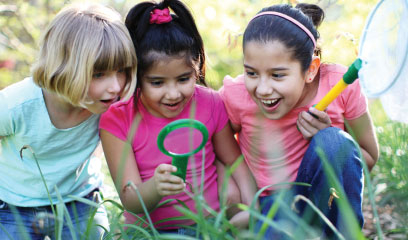
Catch That Bug!
Inexpensive bug catchers make observation easier. Simple plastic boxes with removable lids can be temporary hotels for crawly critters. Some bug catchers have magnifying lids that make detailed observations easier and protect little invertebrates from overzealous chubby fingers. Common city bugs you can find are potato bugs, shiny black beetles, grubs, centipedes, flies, caterpillars, butterflies, moths and spiders.
My kids love The Bug Book & Bug Bottle by Hugh Danks, a bug ID book accompanied by a bug bottle, as well as a simple magnifying glass, and a kid-sized journal to record what you find. You can also order a wide variety of inexpensive tools at acornnaturalists.com and at insectlore.com. Another good field guide is Insects of the Pacific Northwest by Peter Haggard and Judy Haggard. We also use a spectacular government website on local caterpillars, butterflies and moths to identify what we find, learn what they eat, and see what habitat they live in. One caveat, though: teach your child to stay away from bees and wasps, and do not hold hairy caterpillars in your bare hands until you know if the hairs can irritate the skin (we found this out the hard way!)
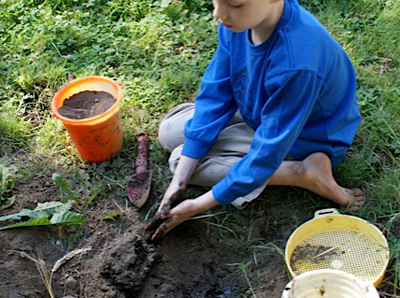
Dig a Hole
To keep your child from digging in your freshly prepared flower beds, designate a spot for digging. Give him his own shovel and bucket and watch him go to work.
Scraps of lumber, rocks, small cars, plastic dinosaurs, sticks, or even plant parts become accessories for his imaginary creations. You get bonus points for allowing a container of water for his use. My kids love finding worms and bugs in the dirt, making roads for their cars and trucks, and making mud pies. And don’t worry about germs; recent studies have found beneficial microbes that help our brains and bodies stay healthy.
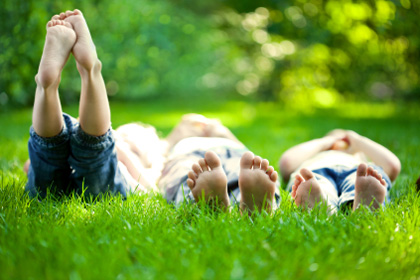
Just Sit
Find a quiet corner with your kids and cultivate the art of sitting and watching. After a few minutes, birds and other wildlife will become more comfortable with you, and may come close by. Even very young children are capable of pretending they are creatures hiding.
This activity works particularly well in view of a bird feeder, where kids can observe birds eating and flitting back and forth. In my work with kids, I’ve found that they will settle into watchfulness more easily if I participate with them, and use an exaggerated whisper. I teach them how to sneak with quiet footsteps, how to slowly creep up on a bird or a squirrel, and I am careful to model stillness and wonder. When you can be calm with a child, and point out what you observe as if it is incredibly special and magical, they will be more likely to imitate your attitude.
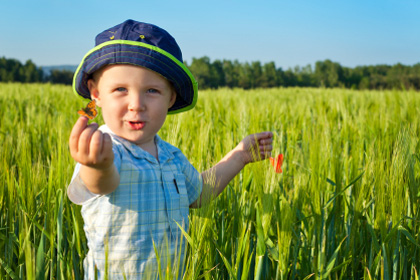
Match Nature’s Colors
If you have leftover paint chips from a home improvement project, try to match the colors on them with something in nature. You can also make your own “color chips” using crayons or colored pencils on index cards.
How many different shades of green or brown can you find? Can you see all the colors of the rainbow? This is a great way to get kids and adults to look more closely and really pay attention to what they are seeing. For more information (and a whole host of other things to do), see the Kids’ Garden Activity Set by Whitney Cohen and Roberta Arenson.
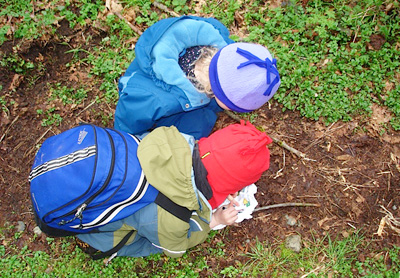
Plan a Nature Scavenger Hunt
Kids love the idea of finding treasure, and a scavenger hunt is a fun way to help kids notice their surroundings in a new way.
You can make your own scavenger hunt using clip art from the web or photos from magazines. This allows you to tailor the hunt to your habitat and season. We’ve done scavenger hunts in our yard, at a park and while on short nature walks. If you’re feeling short on time or creativity you can also go online to find hunts made by other people. Nature Rocks.org has two for different age groups.
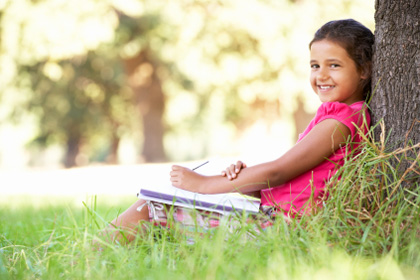
Create Ephemeral Art
This one requires a bit more preparation, but the possibilities for expression are endless. Artist Andy Goldsworthy creates works of art outside using only natural materials – you and the kids can do it, too.
For inspiration, check out his book Andy Goldsworthy: A Collaboration with Nature, or go online to find examples of how he uses rocks, flowers, leaves, and dirt to make pictures in various environments. Try to make your own creation using what you can find outside. For more information, check out the Nature Collaboration section on morning-earth.org. Here you can find examples of other nature artists, and find samples of what children have done.
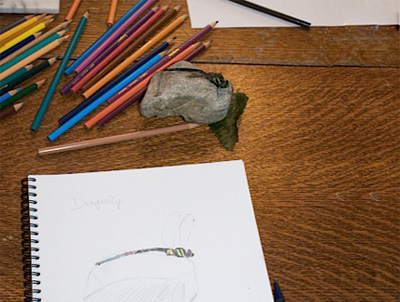
Make a Sound Map
Find a spot in nature where you can sit for a moment and relax. Close your eyes and listen – what sounds do you hear? Imagine your ears can hear in a giant circle around them.
On a piece of paper, mark an X in the center. Write a symbol describing the sound of a bird or the wind, in the direction you hear it. I’ve led this activity for both children and adults, and we are always amazed at what we hear when we truly listen. I like to use a 5x7 index card or a small clipboard with paper. Colored pencils or crayons can be used to draw a symbol or write words describing the sounds around us.
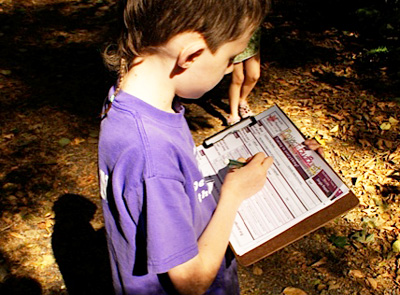
Become a Citizen Scientist
Join a citizen scientist project such as Project Feeder Watch, Celebrate Urban Birds, or Project Bud Burst, where kids can look for data in nature, fill out easy forms online or on paper, and help real scientists with real research projects.
You can make these projects as easy or as involved as you wish. Each of these sites has abundant background educational material to help you on your journey. In the projects that we’ve done, I appreciated having specific things to look for, and the kids got a good taste of the scientific method and how scientists conduct research. They also enjoyed entering their data online and viewing what other people found around the country.
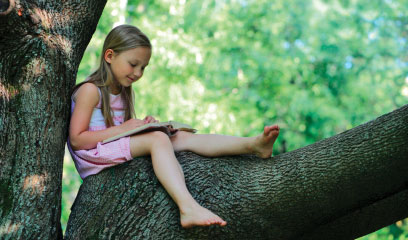
Study Up
Here are few ways to extend the value of your time in nature. Hit the books – follow up observations or questions that arise with books from the library. Draw what you find – get or make a small notebook that your child can use to draw or write about what she sees. Or keep a running nature journal for your neighborhood, where you can keep track of observations and seasonal changes. Have a chat – talk later about your time outdoors and what their favorite part was. This reflection helps to reinforce what was learned, and helps children to look forward to the next time they get to go outside.
To read more, please visit: https://www.parentmap.com/article/11-fun-ideas-for-exploring...











